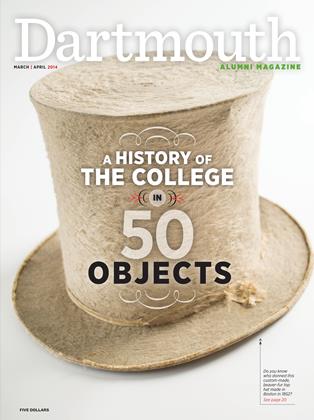HOW DO YOU PRESERVE AND DOCUMENT THE largest terrorist attack on U.S. soil while presenting it in a way that deepens public knowledge without traumatizing visitors? This has been Ramirez’s challenge since 2006, when she was named chief curator for the National September 11 Memorial Museum in New York City. Scheduled to open at the end of May, the museum has two primary components—an historical/analytical side and a memorial side. “I saw this as a real opportunity to develop a collection about humanity at the start of the 21st century. Who are we as a people? What connects us? What divides us?” says Ramirez, who transferred to Dartmouth from Smith College to study with renowned art historian John Wilmerding and later earned a Ph.D. in American studies from Boston University.
Among the large artifacts on display are a “horribly bruised firetruck” and part of an antenna from the World Trade Center’s north tower, according to Ramirez. The displays also include smaller, more personal items. “It might be a pair of glasses with a lens that’s missing or a wallet that was singed, or a receipt from dinner the night before. This material is so potent, it’s so intimate and sad, that we had to figure out how to preserve it and present it in a way that was deeply mindful and respectful,” she says. Ramirez hopes the museum ultimately conveys an optimistic story: “If the museum can facilitate appreciation of how the 9/11 attacks revealed our human connectedness and vulnerabilities, then we will have achieved something important.”
Ramirez describes her 9/11 museum staff as “part of that wave of third- responders. This was something we could bring our professional experience to.”
“This material is so potent,” says the 9/11 museum director.
 View Full Issue
View Full Issue
More From This Issue
-
 Cover Story
Cover StoryABBEY D’AGOSTINO’S RACING SPIKES
March | April 2014 -
 Cover Story
Cover StoryJOHN RASSIAS’ EGG
March | April 2014 -
 Cover Story
Cover StoryELM TREE LEAF
March | April 2014 -
 Cover Story
Cover StoryPIECE OF WOOD FROM MOLLY BLACKBURN HALL
March | April 2014 -
 Cover Story
Cover StoryPEAVEY HEAD
March | April 2014 -
 Cover Story
Cover StoryLONE PINE
March | April 2014
Bonnie Barber
-
 Article
ArticleSeeing Red
Jul/Aug 2004 By Bonnie Barber -
 Article
ArticleSaving the Whales
Mar/Apr 2007 By Bonnie Barber -
 Article
ArticleNewsmakers
Nov/Dec 2009 By BONNIE BARBER -
 SEEN AND HEARD
SEEN AND HEARDNewsmakers
Nov/Dec 2010 By BONNIE BARBER -
 Article
ArticleNews Makers
May/June 2012 By BONNIE BARBER -
 SEEN AND HEARD
SEEN AND HEARDNewsmakers
Nov - Dec By BONNIE BARBER







